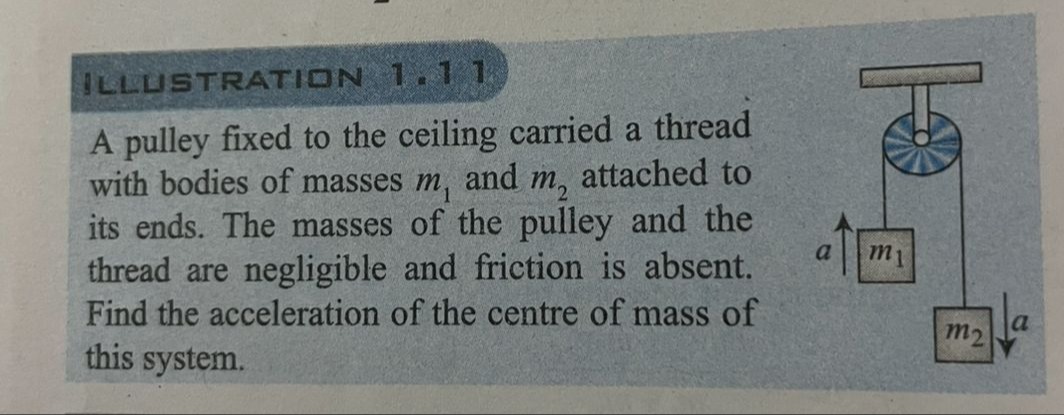Question
Question: A pulley fixed to the ceiling carried a thread with bodies of masses $m_1$ and $m_2$ attached to its...
A pulley fixed to the ceiling carried a thread with bodies of masses m1 and m2 attached to its ends. The masses of the pulley and the thread are negligible and friction is absent. Find the acceleration of the centre of mass of this system.

(m1+m2)2(m1−m2)2g downwards
Solution
Let m1 and m2 be the masses of the two bodies. Let T be the tension in the thread. Let a be the magnitude of the acceleration of each mass. Assuming m2>m1, mass m1 accelerates upwards and mass m2 accelerates downwards.
The equation of motion for mass m1 (upwards is positive): T−m1g=m1a (1)
The equation of motion for mass m2 (downwards is positive): m2g−T=m2a (2)
Adding equations (1) and (2): (T−m1g)+(m2g−T)=m1a+m2a (m2−m1)g=(m1+m2)a a=m1+m2(m2−m1)g
If we choose the upward direction as positive, the acceleration of m1 is a1=aj^=m1+m2(m2−m1)gj^. The acceleration of m2 is a2=−aj^=−m1+m2(m2−m1)gj^.
The acceleration of the center of mass of the system is given by: aCM=m1+m2m1a1+m2a2 aCM=m1+m2m1(m1+m2(m2−m1)gj^)+m2(−m1+m2(m2−m1)gj^) aCM=m1+m2m1+m2m1(m2−m1)g−m2(m2−m1)gj^ aCM=(m1+m2)2(m2−m1)g(m1−m2)j^ aCM=−(m1+m2)2(m2−m1)2gj^
The acceleration of the center of mass is in the downward direction (since j^ is upwards). The magnitude of the acceleration of the center of mass is (m1+m2)2(m2−m1)2g.
If m1>m2, then m1 accelerates downwards and m2 accelerates upwards with magnitude a′=m1+m2(m1−m2)g. In this case, a1=−a′j^=−m1+m2(m1−m2)gj^ and a2=a′j^=m1+m2(m1−m2)gj^. aCM=m1+m2m1a1+m2a2=m1+m2m1(−m1+m2(m1−m2)gj^)+m2(m1+m2(m1−m2)gj^) aCM=m1+m2m1+m2−m1(m1−m2)g+m2(m1−m2)gj^ aCM=(m1+m2)2(m1−m2)g(−m1+m2)j^=−(m1+m2)2(m1−m2)2gj^.
In both cases, the acceleration of the center of mass is downwards with magnitude (m1+m2)2(m1−m2)2g. We can write this as (m1+m2)2(m1−m2)2g downwards.
